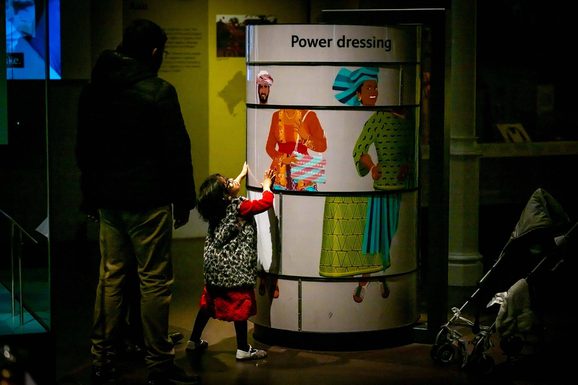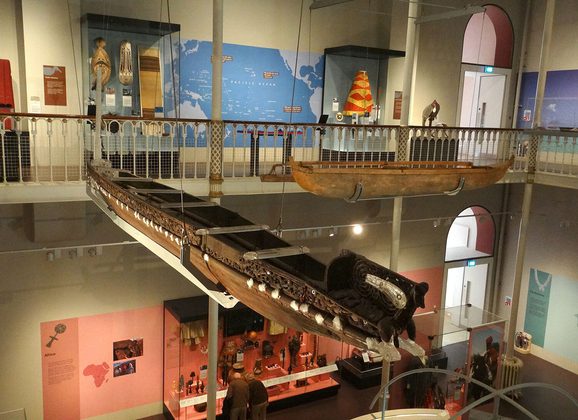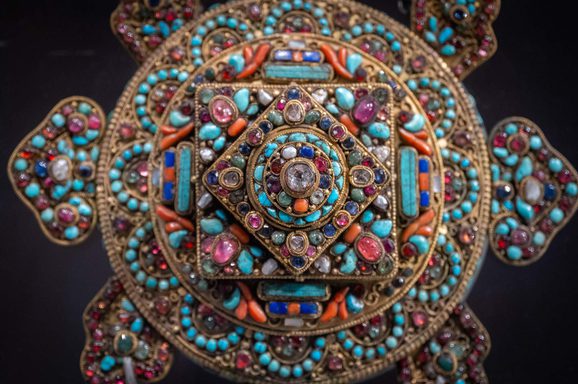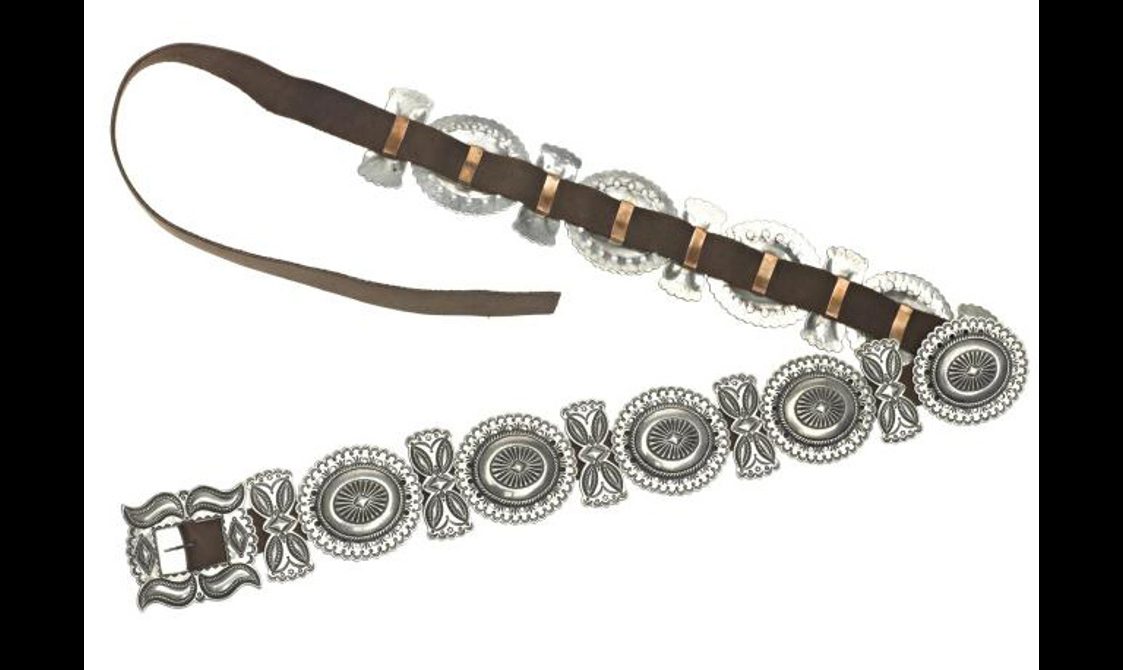
World Cultures galleries
How can you travel around the world without leaving Scotland? By visiting our World Cultures galleries.
The objects on display are drawn from some of museum’s oldest collections and demonstrate Scotland's international links. The galleries are organised by theme, both offering insights into the individual cultures and providing unexpected juxtapositions.
Galleries to visit

Patterns of Life
Location: Level 1
Patterns of Lifeexplores the dynamic interaction between people and their possessions throughout the stages of life, from across the four continents. Possessions can reflect identity, mark important life events, and serve as a means of expression, such as the modern African custom of choosing a coffin in the shape of a favourite object.

Living Lands
Location: Level 1
Living Lands presents objects made by indigenous peoples, from the North American Arctic to the deserts of Australia, and considers how landscape influences the way people lead their lives and what they believe. The displays also emphasize the modern situation, through contemporary art such as works by the Australian artist Danie Mellor.

Imagine
Location: Level 1
Young children can develop their senses in the vibrant Imagine gallery, by interacting with shapes, colours, patterns and motifs taken from around the world.

Facing the Sea
Location: Level 3
Facing the Sea is the only gallery in the UK dedicated to the cultures of the South Pacific. The gallery looks at the cultural diversity of this region and explains how Pacific Islanders’ lives are framed by their relationships with the sea. Here you can find our Maori waka, or war canoe, sensitively completed in Perspex by contemporary artist George Nuku.

Performances and Lives
Location: Level 3
Performance and Lives celebrates the diversity of music, dance and costume around the world. Not only can you see various instruments on display, ranging from classical to folk, but also listen to recordings and play instruments specially made for the gallery by artist Victor Gama.

Inspired by Nature
Location: Level 5
Inspired by Nature examines the ways in which humanity has engaged emotionally, spiritually, religiously and culturally with nature through art. Don’t miss the elegant, evocative poppies by contemporary sculptor Maryam Salour.

Artistic Legacies
Location: Level 5
Also on Level 5, Artistic Legacies illuminates the relationship between artistic traditions and the work of contemporary artists, exemplified by African artist Gérard Quenum’s arresting sculpture L’Ange.

Ancient Egypt
Location: Level 5
Explore the remarkable culture and achievements of the ancient Egyptians, and come face to face with individual objects and the people who made, owned, and used them, as well as the archaeologists who discovered them centuries later.

Exploring East Asia
Location: Level 5
In Exploring East Asia, you can experience the sights and sounds of three fascinating and dynamic cultures: China, Japan and Korea. Among the highlights are a Chinese lacquerware rice measure from the Ming dynasty, a Japanese suit of samurai armour from the late Edo period and a rare and important early survival Korean lotus-shaped cup and stand from the 13th century.
Object highlights

Maryam Samour's cermaic poppy sculptures can be found in the Inspired by Nature gallery.

Female doll figures of moulded plastic, Africa, West African, Mali, Mopti, probably made in China, acquired 2009. Museum references V.2009.241 and V.2009.242.

Coffin in the shape of a Mercedes-Benz car, wooden, white painted lower body with silver, black and orange details, with leopard skin fabric upholstered seats inside coffin: Africa, West Africa, Ghana, Accra, Ga people, by Paa Joe, c. 1998.

The kingfisher headdress. On display in the Exploring East Asia gallery.

Mixed media work entitled The Storyplace (A History of Two Worlds), pastel, pencil, Swarovski crystal and wash on paper: Australasia, Australia, Queensland, Danie Mellor, 2008.

Anthropoid coffin of the estate overseer Khnumhotep, Ancient Egyptian, Middle Egypt, Deir Rifa, Middle Kingdom, second half of the 12th Dynasty, c.1847-1808 BC. Museum reference A.1907.713.5.

Weituo sculpture on display in the East Asia gallery at the National Museum of Scotland. Museum reference A.1937.505.

Concho Belt by Perry Shorty in 2019. Made from Sterling silver, copper and leather. Museum referenceV.2009.221.
Stories from the galleries
- Discover

Casing stone from the Great Pyramid of Giza
This block is one of the few surviving casing stones from the Great Pyramid of Giza, built for King Khufu. It is the only pyramid casing stone on display outside Egypt.Khufu was the King of Egypt around 2500 BC. He is also known as Cheops,… - Discover

The Qurna Burial: The discovery of a royal woman’s grave in Egypt
In 1908, an intact burial of a woman and a child was discovered in Qurna, Thebes, Egypt. Over a hundred objects were found in the burial, but the identities of the woman and child are a mystery.The find was made by a team of Egyptian… - Discover

Native American Jewellery
Navajo and Pueblo jewellery originates from the Southwest United States. It is denoted by, though not restricted by, its use of turquoise and silver. National Museums Scotland (NMS) has early and contemporary examples of this jewellery.… - Discover

Bringing a Māori waka taua back to life
Māori craftsmanship and museum conservation bring to life one of our most unusual and intriguing objects.How did the waka come into the collection?The Māori waka taua (war canoe), was first added to the museum’s collection in 1854. It was…
Gallery accessibility
Getting to the galleries
Lifts and escalators
Lifts are available to all floors of the museum. You can check the museum map or ask a member of the Visitor Experience team for the nearest lifts. Information on lift dimensions is available on the AccessAble website.
In the galleries
Seating
There are seating options in the World Cultures galleries, either in the form of permanent seats or foldable chairs. Please ask a member of the Visitor Experience team for the nearest seats.
Lighting and noise
Most of the World Cultures galleries have low lighting levels to protect the items on display.
The Performance and Livesgallery has musical instruments which can be played.
Check our sensory map to explore all the different sensory experiences in different parts of the museum.
Large print guides
Large print guides can be found in every gallery of the museum. Please remember to return them after use so that other visitors can use them.
Facilities
Toilets
Accessible toilets are available on Levels 0 and 3, as well as a Changing Places (U) toilet in the Entrance Hall on Level 0. You can access the museum map to find those nearest to you or ask a member of the Visitor Experience team.
Cloakroom and storage
Self-service lockers are located in the Entrance Hall. The lockers come in three sizes which accommodate coats and small bags right up to small flight cases.
There is buggy storage available in the museum. It is located on Level 1 of the Scotland galleries, behind the Kingdom of the Scots gallery.
Quiet spaces
If at any time you or someone you are visiting with finds the visit overwhelming, a member of staff can direct you to quieter areas in the museum. The sensory map also identifies the quieter spaces.
For full access information for the National Museum of Scotland buildings, find out more on our accessibility page.
You might also like

Plan your visit
Find out how to get to the museum and make the most of your visit.
Global Arts, Cultures and Design department
Our Global Arts, Cultures and Design collections include internationally important material from across the world.
Search the collections
Our online database contains a selection of the 12 million objects and specimens in our collections.